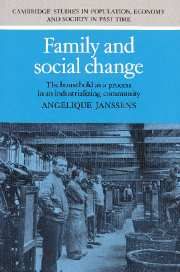Book contents
- Frontmatter
- Contents
- List of figures
- List of tables
- List of appendices
- Preface
- 1 Family and industrialization
- 2 The industrializing context: continuity and change in nineteenth-century Tilburg
- 3 Sources and methods
- 4 Family structure through time
- 5 Family life and the social structure
- 6 Family structure and geographical mobility
- 7 Family and work: the effect of the family economy on the structural characteristics of the household
- 8 Conclusion
- Appendices
- Bibliography
- Index
- Cambridge Studies in Population, Economy and Society in Past Time
5 - Family life and the social structure
Published online by Cambridge University Press: 05 March 2012
- Frontmatter
- Contents
- List of figures
- List of tables
- List of appendices
- Preface
- 1 Family and industrialization
- 2 The industrializing context: continuity and change in nineteenth-century Tilburg
- 3 Sources and methods
- 4 Family structure through time
- 5 Family life and the social structure
- 6 Family structure and geographical mobility
- 7 Family and work: the effect of the family economy on the structural characteristics of the household
- 8 Conclusion
- Appendices
- Bibliography
- Index
- Cambridge Studies in Population, Economy and Society in Past Time
Summary
This chapter is concerned with the second of our four research strategies: the study of the relationship between the family and the social structure of an industrializing society. Through the examination of class position in relation to the structural evolution of the household a better understanding may be gained of the relationships between the macro-processes of social change and the micro-processes affecting the family. Again the perspective employed is a dynamic one. This is not only because different aspects of the family along its cycle are involved, but also because the relationships between the family and the social structure are analysed through time. To begin with I will look into the issue of social class and family structure. Next, the relationship between parents and children is further discussed, this time taking into account the social background, while the final section of this chapter deals with family structure and social mobility.
Family and social class
In the previous chapter we dealt with family and household disregarding social and economic variables. However, the historic evolution of the family cannot be fully understood in isolation from the social and economic structure of the society of which it is part. This by now widely accepted point of view in fact constituted one of the major points of criticism on the early work of the Cambridge Group which tended to abstract households from their social and economic context.
- Type
- Chapter
- Information
- Family and Social ChangeThe Household as a Process in an Industrializing Community, pp. 115 - 159Publisher: Cambridge University PressPrint publication year: 1993

